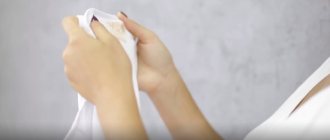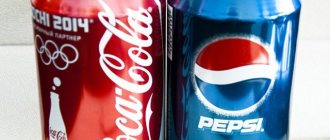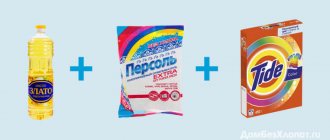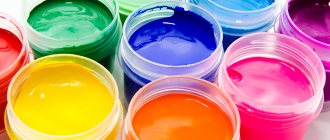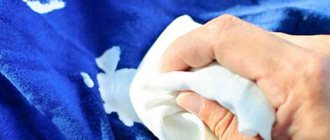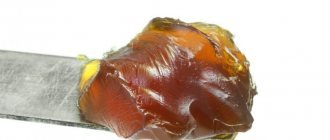Vehicle owners often encounter problems when antifreeze, antifreeze or engine oil gets on their clothes. These substances leave greasy residues that are difficult to remove. Standard washing by hand or in a washing machine will not help here. Antifreeze or antifreeze, machine oil are strongly absorbed into the fabric and create a film on the surface.
Even after several washes, faded traces of products will still remain on the fabric. Therefore, for this problem, you will have to resort to special methods. In this article we will learn how to remove antifreeze from clothes. And we’ll figure out how to remove machine oil stains.
How to remove antifreeze stains from clothes, how to wash antifreeze at home?
You can stain your clothes with antifreeze not only when repairing a car. This problem may arise while traveling on public transport. Such contaminants are difficult to remove. Despite this, you should not rush to throw away something stained with antifreeze. There are effective means that can be used at home to completely remove such stains from fabric.
What is antifreeze?
This term refers to all liquids that do not freeze at low temperatures. Most often, antifreeze is a name given to coolants designed to prevent damage to car parts caused by the expansion of water when it freezes, as well as to ensure proper operation of the cooling system in winter. This substance feels like oil. When it comes into contact with fabric, it penetrates deeply into its fibers.
How to remove a fresh antifreeze stain?
Any fresh stains, including those from antifreeze, are much easier to remove from clothes when they have not yet become deeply ingrained into the fabric. There are several means by which you can cope with this task. You can remove such stains using dishwashing liquid, chalk, toothpaste, a mixture of ammonia and turpentine, or magnesia powder and ether. The main thing is to strictly follow the recommendations for their use.
Product preparation
Before you try to remove antifreeze stains from clothes, you need to properly prepare them. First you need to blot the stained area with a napkin to remove excess substance. This must be done carefully, otherwise the liquid will be smeared onto the fabric and the problem will worsen significantly. Then you should generously pour salt, soda or powdered chalk onto the contaminated area. After the product has absorbed the antifreeze, shake it off the item.
Spot treatment
Information on how to properly prepare and use cleaning products to remove such contaminants is presented in the table:
| Main ingredients | Preparing the Cleanser | Application |
| Dishwashing liquid | Dilute the liquid with a small amount of warm water | Apply the soap solution to the stain, leave for 10-15 minutes, lightly rub and wipe the treated area with a damp cloth. |
| Ammonia, turpentine | Mix the components in a 1:1 ratio | Apply the mixture to the stained area. After 5–10 minutes, wipe the treated area with a damp cloth. |
| White toothpaste | Not required | Apply the paste to the stain. Scrape it off after it is completely dry. |
| Magnesia powder, ether | Mix the ingredients until you get a paste | Apply the mixture to the stained area. Gently rub it and wipe with a damp cloth. |
Washing the product
After using any of the listed cleaning agents, you need to wash the soiled product. This measure will allow you to completely remove particles of the cleaning agent and remove stains. The item must be washed in the manner recommended by the clothing manufacturer. Regardless of the washing method, you need to use powder or gel. Air conditioning is available upon request.
How to return clothes to their original cleanliness
It is easy to put an antifreeze stain on your workwear during car repairs, but it is more difficult to remove. However, experienced mechanics and car enthusiasts can easily cope with this task. The main thing is to wipe off the stain at a time when it has not yet eaten into the jeans or overalls. Then it will be possible to deal with the contamination in 10-15 minutes.
Automotive lubricant consists of fats, so substances that can dissolve organic and inorganic fats are used to remove stains . Suitable for this purpose:
- Washing powder for manual or automatic washing.
- Finely grated laundry soap. It contains an alkali that neutralizes fats;
- Crushed school chalk or crushed stone is limestone. They contain lime, which also perfectly dissolves fatty acids;
- Dishwashing liquid like Fairy or Sorti. These products contain substances that break down fat molecules even in cold water.
The principle of operation of the listed stain removers is approximately the same: liquid or powder is applied to a fresh stain (the sooner the better), which should then be thoroughly rubbed with a rag or an old toothbrush. You should not rub a fresh mark with a rag soaked in water: this will absorb the fat even more into the material. This must be done for at least 10 - 15 minutes, otherwise there will be no effect.
After this, the clothes are left for another 10 - 15 minutes so that the remaining liquid is absorbed and the solvent begins to act. It is then washed in warm water, paying special attention to the stain. Then you can wash it in the machine on the “heavily soiled clothes” mode at a temperature of at least 90 degrees. This method removes any greasy traces from the suit: sunflower or olive oil, fatty cutlets and cakes.
How to treat an old stain?
You can wash clothes from such contaminants that have become deeply embedded in the fibers of the fabric using:
- refined gasoline;
- solvent;
- Antipyatin soap.
The first two products have a fairly aggressive composition, so they must be handled with caution. Detailed information on how to properly use the listed tools is presented in the table:
| Cleanser to combat old antifreeze stains | Application | Precautionary measures |
| Refined gasoline | Generously moisten two clean napkins with flammable liquid, place one under the stained area, and place another on it. After 30 minutes, wash the item. | Regular gasoline cannot be used. When working with flammable liquids, you need to wear rubber gloves away from open flames in a well-ventilated area. |
| Solvent | Apply the liquid to the stain. After half an hour, wash the soiled clothes. If necessary, repeat the procedure. | Use the product only to clean dark-colored items. Before re-treating the stain, make sure that the fabric has not changed color. |
| Antipyatin soap | Lather the stained area moistened with water. After 15–20 minutes, wash the item. | None. |
Source of the article: https://protkan.com/uhod/chem-otstirat-antifriz-s-odezhdy.html
How to wash antifreeze from clothes, How to wash antifreeze from a jacket.
How to remove antifreeze from clothes
Not only a workshop specialist or a driver, but also just a tram passenger can smear clothes in fuel oil, oil, or fuel. This kind of contaminant is difficult to remove, since it does not dissolve in water and is insensitive to the action of standard washing powder. To wash a white or colored jacket, you will have to resort to tricks.
Fuel oil on a red jacket
How to wash workwear
The sooner you start removing the stain, the less effort you will have to make to clean your suit. This applies to any contamination. Before putting the item in the washing machine, you need to at least partially remove fresh traces of dirt by hand washing. When choosing how to remove machine oil from clothes, stick to what you have at hand. Don't waste time: the oil is absorbed into the fabric instantly.
Workwear is difficult to wash, so it is better to use the most powerful washing powders . Individual stains are washed off on your hands, then the item is placed in the machine. It is advisable that the machine wash last for at least an hour. Overalls should be placed in the car separately from other things. For example, let there be four sets of workwear and once a month wash three of them in the machine at the same time: three jackets and three pairs of trousers.
If you can’t use an automatic machine, things are pre-soaked and only then processed manually in hot water. To remove stains, rub the fabric with a rough washcloth or use a special board with a ribbed surface. A good option is a small ultrasonic machine. It will cope with oil stains and other contaminants, but traces of machine oil should still be rubbed with a soap or chalk solution first.
Removing traces of grease is a difficult task, but doable. To do this, you just need to know the basics of organic chemistry and try: not a single stain, even the smallest one, will disappear on its own. Skillful hands that are not lazy to wash are half the success.
Not only a workshop specialist or a driver, but also just a tram passenger can smear clothes in fuel oil, oil, or fuel. This kind of contaminant is difficult to remove, since it does not dissolve in water and is insensitive to the action of standard washing powder. To wash a white or colored jacket, you will have to resort to tricks.
Fuel oil on a red jacket
How can you remove fuel oil or machine oil?
This type of pollution is one of the most difficult. The substances are mixtures of ethers, resins, and asphaltenes. They are insoluble in water and very poorly soluble in acetone or alcohol, so they can only be eliminated with the help of sufficiently strong acids and alkalis.
It is worth noting that it is easier to clean such contamination from the wrong side of the jacket. In addition, before using any product, you must first conduct a test. Relatively thin fabric or complex fabric, like suede, does not withstand many home treatments.
- If the mark is small and has not had time to dry, dishwashing liquid will usually help. The affected area of fabric is filled with liquid for 30 minutes, then the contamination is cleaned with a stiff non-metallic brush. After this, the item is sent for washing.
- Diesel or gasoline may help. A cotton swab is soaked in fuel and the substance is carefully wiped off the fabric. To wash a greasy jacket - for example, a work uniform, it is soaked entirely in diesel fuel for 2 hours, and then hung out to dry in the fresh air. Only after this are the clothes washed.
- Aromatic oil can also remove fuel oil. This method is used on thin fabrics. A cotton pad is soaked in oil and wiped from the reverse side of the fabric. And then the item is washed in the hottest water allowed by the instructions.
- A fresh trace of engine oil or fuel oil is removed using a blotter. A sheet of blotting paper is placed on the stain and ironed with a hot iron. The substance is absorbed into the paper and separated from the fabric. It will not be possible to completely get rid of dirt: after the procedure, you should wipe the residue with eucalyptus oil or ammonia, and then wash it.
- You can remove the greasy stain using car shampoo. Soak a cotton swab in the product and then remove any traces of grease or oil.
- Another way to eliminate marks even from white clothes is starch and white clay. The substances are mixed in equal parts. Then they are diluted with ammonia and applied to the dirt. The mixture must dry, after which it is considered a brush along with the fat. The jacket is then washed as usual.
Stains on a light jacket
How to remove paint and ink from a pen
Such marks can be made by taking into account the fabric from which the clothing is made.
- The easiest way to wipe a leather or faux leather jacket is with sunflower or olive oil. There is no need to apply much effort, and you should make sure that the stain does not increase in size. If the paint or ink from the pen has already dried, resort to a solvent - white alcohol, acetone, turpentine. Soak a cotton swab in the liquid and carefully wipe away colored marks from clothing.
- You can remove dirt from a Bolognese jacket using warm alcohol. The liquid is heated, a cotton pad is moistened in it and the mark is wiped off.
- Raincoat fabric also absorbs dyes well, but in this case it is easier to remove them. The dirty area is rubbed with laundry soap, and then the clothes are washed in a washing machine.
- Old marks from pens can be removed using a solvent. Pour this liquid over the contaminated area and leave for 20–30 minutes, then rub the material intensively with a toothbrush until the marks from the handle disappear.
- An old dye stain should first be softened. To do this, the fabric is moistened with warm alcohol, soda solution, or even margarine or butter. After softening the area, the fabric is impregnated with a solvent and the material is cleaned with a brush.
How to remove grease stains from a jacket
Greasy marks from cream, oil, antifreeze can be removed in several ways.
- The easiest way to remove fresh dirt is with absorbents. Talc or baking soda is mixed with a drop of water to form a paste. The mixture is applied to the greasy fabric and left for 5 minutes until it dries. Then the powder is cleaned off. As a rule, no traces are left.
- You can wash fat from a synthetic padding jacket if you use starch. Add a drop of water to the starch and apply the mixture to the greasy mark. You need to hold it for at least half an hour. Then the starch is simply peeled off. There is no need to actually wash the item.
- Fatty stains can be removed with lemon or onion juice. The juice is simply squeezed onto the plot. Organic acid dissolves fat without a trace. Lemon juice is used for white clothes, onion juice for dark ones.
A greasy jacket will take longer to remove.
- First, 2 tablespoons of washing powder are dissolved in 500 ml of water, and then a section of fabric is washed using a brush and this mixture. A piece of soft material is soaked in vinegar and the greasy mark is wiped, after which the jacket must be rinsed and dried.
- Another method for greasy clothes is turpentine or gasoline. But, however, it is only suitable for hard fabrics. The area is soaked with water or gasoline, covering only the stain. Then put blotting paper soaked in gasoline under it, and wipe the greasy mark with a soft cloth moistened with turpentine. The item is thoroughly washed with soapy water.
Because You are not logged in. To come in.
Because The topic is archived.
blah. just to joke. Yes, raise the level.
People, I want to ask those who have encountered a similar problem. Or knows how to solve it. ¶
Advertisements on NN.RU – Auto
We also offer you: 210.12.00.03 (210.12.11.01G, 210E12.01) hydraulic motor for splined reverse. 210.12.01.03 (210.12.11.00G, 210E.12.00). Price: 1,000 rub.
Extend the chassis (frame) on Gazelle Next, Gazelle farmer under a body of 4.2 m, 5.1 m and 6.2 m. Extend the frame on Gazelle Next, Gazelle Gas 3302. Price: 25,000 rubles.
A certified truck conversion organization invites you to: lengthen, re-extend and convert, p.
Manufacturing of a broken-type platform with retractable ramps on the GAZ-33023 Gazelle-farmer chassis. Technical characteristics of the tow truck.
Today, Nizhny Novgorod fast food lovers have a real holiday: a new worldwide outlet has opened on the renovated Nizhne-Volzhskaya embankment.
A street film festival will be held in Nizhny Novgorod for the second time. Short films by young Russian directors will be available for free.
We are forced to buy unnecessary things because they come with what we need. Moreover, according to the sellers, they are inseparable, like Jack and Rose.
An accident occurred in the Moskovsky district of Nizhny Novgorod: a girl was swinging her friend, but the swing suddenly fell. As a result.
When removing large and deep stains, a so-called halo may occur. To prevent its appearance, it is necessary to clean the products with a brush from dust, moisten the fabric around the stain with water, placing several layers of hygroscopic fabric, such as gauze, under the stain from the reverse side, and only after this can you begin treating the stain with a swab moistened with a solvent. When working with solvent, you should follow the rule: wipe the stain in a circular motion from the edges to the center so that it does not spread. The dissolved contaminant transfers to the underlying fabric. The treatment should be repeated 2-3 times, changing the tampons and the underlying fabric as they become dirty. When the stain disappears, vigorously wipe the cloth with a dry cloth in all directions until all traces of it are removed.
Stains from white linen or cotton fabric can be removed using bleaches.
Stains from vegetable or animal oil: • Small fresh stains are removed with gasoline, turpentine, acetone, old dried ones - with a solution composed of 10 g of gasoline and 10 g of acetone. • When working with acetone, test the fabric for resistance to this product: dip its threads or a piece in acetone. • Fresh grease and oil stains can be removed from any fabric by ironing the fabric with an iron heated to 100 °C through several layers of blotting paper placed on both the back and front sides of the fabric. • To remove fresh stains, we can recommend another method: prepare a warm solution of ammonia (1 teaspoon of ammonia, 1 teaspoon of any all-purpose detergent and 1/2 cup of water). Using a swab soaked in this solution, wipe the contaminated area, and then iron it through a clean white cotton cloth with a hot iron. • Remove large greasy stains as follows. Pour gasoline or turpentine into two enamel or glass bowls. Gather the contaminated area in your hand and bandage it on the clean side. Dip the resulting ball into the solvent several times, squeezing it out and immersing it again. Repeat the operation in a second bowl containing clean solvent. Rinse with water.
For grease or oil stains on clothes made of thick synthetic fabric, sprinkle with potato starch and rub with a damp towel. Repeat several times until completely removed.
Try removing grease or oil stains on velvet this way: fill a linen bag with clean, dry, warm sand and tap it on the stain until it disappears. If this is not enough, moisten the stain with gasoline and treat it again with a bag of sand.
Source of the article: https://kalina-2.ru/remont-vaz/chem-otstirat-antifriz-s-odezhdy
Antifreeze is washed off from clothes - All about Lada Granta, How to wash antifreeze off a jacket.
Antifreeze is washed off from clothes
Householders sometimes have to think about the topic: how to clean machine oil? This is a question that has been worrying people for more than a decade. Living side by side with cars, doing vehicle repairs, or even traveling by vehicle leads to an unpleasant stain from motor oil appearing on your clothes. This substance is very greasy and tends to deeply saturate fabric fibers, so removing it from your favorite shirt or trousers is not a trivial matter. Another source of problems for clothing during repair work is antifreeze, a mixture of alcohol and dyes. Our review will help you figure out how to remove machine oil from any clothes without ruining them.
Machine oil stains are quite difficult to remove.
Two spoons of engine oil can ruin the entire water supply on a ship. Some things don't go together
Why do you need to remove stains?
In a car enthusiast's wardrobe there will be several jackets or jeans damaged by stains of varnish, paint and motor lubricants. Such clothes, especially light ones, immediately lose their presentation: you can no longer wear them to work. The fats contained in the lubricant gradually roughen the fabric. It is uncomfortable to wear and may cause redness, irritation and abrasions on the skin. In addition, it is inconvenient to wash by hand. Over time, the spots do not fade, but, on the contrary, appear even more clearly.
All that remains is to throw away such clothes or take them to the country. It's a shame to part with your favorite things that could last for many more years.
The biggest problems for motorists and mechanics are motor oil and other lubricants, as well as varnishes and paints. One awkward movement during repair is enough, and you already have to think about how to remove the corrosive liquid. The Internet will tell you how to remove oil from clothes. Watch training videos and read useful tips on this topic.
About washing and more
Regular washing, whether manual or automatic, will not help: faded traces of oil will remain “show off” on the outfit. Moreover, machine processing not only will not remove the dirt, but may even lead to its deepening, that is, it will become more difficult to wash off the dirt than it was before. Conventional washing powders will have almost no effect. Using bleach is risky because it can easily ruin the fabric. These are cotton fabrics. How to wipe off dirt on jeans or a jacket is the question of the century. Dry cleaning? Sending an outfit there is expensive, and such cleaning does not always end well for the clothes.
You will have to be resourceful and use the methods presented below. Remember the general rules for all methods of removing stains from fabrics:
- Fresh dirt is easier to remove than old, dried dirt, so remove dirt as soon as it gets on your outfit.
- Solvents not only remove traces of oil, but sometimes also damage the fabric itself, and sometimes even your hands. Remember to test cleaning agents on an inconspicuous corner of your suit before applying the product in earnest. And always put on household gloves before starting work.
It is best to wash jeans immediately after they have been exposed to oil.
Washing instructions
Washing methods vary depending on the type of material from which stains need to be removed.
- If traces of oil please the eye with their freshness, and the fabric on which they shine does not differ in the rate of absorption of liquids, you can use the following instructions: take a solvent, carefully drip it onto the dirty area and wait 10 - 15 minutes. After this time, you should arm yourself with an ordinary cloth napkin or a clean rag and remove the solvent from your clothes. It is advisable to do this by soaking. At the end of the work, wash the outfit as usual, using washing powders, a basin of water or a washing machine. Liquid dishwashing liquid for greasy dishes is suitable as the above-mentioned solvent.
- Another good product is kerosene, which effectively removes not only machine oil, but also contaminants of a different nature. The liquid is applied to the stain and gently rubbed with a napkin from the edge to the center. When all the oil has been collected, the fabric will need to be washed, following the recommendations on the tag. It is important to take into account that kerosene is an aggressive substance and you can only get rid of stains remaining after treating the stain with very hot water. If the fabric is soft, delicate, then it cannot be washed at high temperatures and it is better not to use kerosene. In this case, pay attention to other solvents.
- Another method for removing oil also applies to fresh stains. To do this, you need to buy white chalk and grind it into powder. They need to sprinkle a dirty, still sticky place and wait until the mineral absorbs the oil - and it does this very well. All that remains is to remove the chalk and wash the fabric.
A machine oil stain can be sprinkled with chalk.
Oil on jeans: how to remove
Jeans are popular clothing among all segments of the population, but they have a very unpleasant quality: they are difficult to wash. And jeans suffer from engine oil no less than any other item of clothing. But all is not lost. If the dirt is fresh, then you can remove it, you just have to try.
- Use a cloth to remove as much oil as you can, then take a solvent and use it on the dirty area. An old toothbrush is a great tool to use to remove stains from your jeans. The solvent can be dishwashing liquid - it removes greasy marks from fabric well. You can use gasoline or kerosene: you need to moisten a cotton swab or disk in them and thoroughly work out the contamination. After the procedure, the outfit will have to be washed, especially one that was cleaned with gasoline.
- Chalk powder is another good old-fashioned way to remove oil from clothes. They scatter it over the affected area and wait until the dirt disappears.
- A solution of ammonia and water is ready to destroy traces of machine oil. The disadvantage is the colossal harm that this product can cause to human health. Use it carefully. Place your clothes on a balcony or other room to avoid inhaling the smell of alcohol and pour the solvent onto the stain. Now all that remains is to wait until it leaves the fabric. The waiting time is just under an hour.
- There are professional sprays ready to remove stains from fabric. Ask your hardware store salesperson for recommendations.
You can buy a special stain remover in the store.
How to wash jeans
Jeans are the most common clothing that often retains greasy stains and oil marks. As soon as you notice an oil stain, immediately blot with a napkin and remove excess oil. Use solvent and an old toothbrush to scrub away dirt.
Gasoline and kerosene, dishwashing detergent, and chalk are also suitable for denim clothing. You can use standard laundry soap. Due to the high content of acids, it removes fresh stains well. We soap the dirty area, leave it for 30 minutes and rinse it off, then wash the clothes with detergent.
Ammonia or ammonia can remove grease and oil stains. Wet cotton wool with the product and carefully treat the contaminated area. After the procedures, wash the items in the washing machine, rinse and leave the items to air to get rid of the smell. How else can you remove an oil stain from jeans, see the link.
Antifreeze: how to remove it?
Car repairs are not only dangerous with machine oil; it is easy to stain your favorite outfit with a substance such as antifreeze, also known as antifreeze. It is difficult to get rid of it, but it is possible, the recommendations offered below will help with this:
- Don't delay your laundry. The fresher the antifreeze contamination, the easier it is to remove.
- Using several wipes, remove as much excess material as possible.
- Take a basin and stretch the fabric over it.
- If the affected outfit is not made of delicate fabric, then pour hot water over the contaminated area. This will help remove the antifreeze.
- Sprinkle a spoonful of laundry detergent onto the stain and work it gently. The dirt must come off.
- In case of difficulties, you should use oxygen bleach. Apply it to the dirty area and wait 10 minutes, it will help remove the dirt.
- All that remains is to wash the fabric and dry it. However, if antifreeze is still showing off on the outfit, do not dry it, but rather repeat the procedure for removing the harmful liquid.
Knowledge and common sense will help the housewife or owner to quickly and without harm to themselves and their clothes clean them of dirt. Even if it's engine oil or antifreeze.
If antifreeze gets on the carpeted floor in the car, it is recommended to wash it with special products that have a gel-like structure, which can be found in hardware stores. They are designed to remove stains from fabric materials. If you don’t have such a product on hand, it is recommended to use a soap solution with the addition of dishwashing detergent, or “Vanisha” for carpets. True, there is some danger here - stains may remain on the coating. Therefore, you should not smear the foam, but scrape it off as much as possible and only then rinse the product off again with clean water.
Some people advise using regular table salt, rubbing it into the stain and then rinsing it off with water.
It is also recommended to use soapy water if antifreeze has spilled under the hood. There are also opinions about the effective effects of whey.
But probably the best way would be this:
Not only motorists can get stains from motor oil on their clothes; it can also be caused by simply using public transport. Machine oil penetrates deeply into the fibers and many people throw away stained clothing without even trying to get rid of it. But it’s worth a try, especially since there are several ways to remove such stains.
How to remove engine oil and antifreeze
To remove antifreeze stains, remove excess substance with napkins and stretch the cloth over a basin or other similar container. Fill the affected area with hot water, then add a spoonful of washing powder. Finally, wash your items using the usual method. If this method doesn't work, use oxygen bleach. Apply the product to the stain and leave for 10 minutes. Then wash and dry the product.
We clean a fresh, newly obtained oil stain using any solvent. You can take acetone or white spirit. Drop a small amount of product onto the stained fabric and leave for ten minutes. Then use a clean, dry cloth or napkin to remove any remaining solvent and wash the items in warm water.
Fresh dirt on natural fabric can be quickly removed with chalk. Apply chalk to the area and leave for 2 hours. Afterwards we remove the excess chalk and wash the product. Chalk is suitable for linen, cotton, silk, chiffon, light denim. Not suitable for dark fabrics.
If you have just placed the stain, sprinkle the sticky area with fine salt and leave for a few minutes. The salt will absorb the fat, after which you can wash the items with good powder or laundry soap. Dish detergent also effectively removes greasy stains. Lightly moisten the affected area with water, apply the composition for half an hour, then rinse and wash the clothes. For white cotton and linen items, you can use chlorine bleach. How to bleach things, read here.
Methods for removing machine oil
Before you begin removing machine oil from the product, you should carefully inspect the fabric and consider all the steps to remove it so that the fabric does not get damaged. If you soak and wash clothes with ordinary powder, it will not be removed, since the oil is well absorbed and forms a film on the fabric. Using bleach will only ruin your clothes.
Using salt
Each type of fabric uses its own stain remover. The fresher it is, the easier it is to remove it. If you just planted the stain, sprinkle some fine salt on it and let it sit for a few minutes. This method is suitable for all types of fabric. When the salt absorbs the oil, simply remove it. This procedure should be done several times if it was not immediately possible to remove it. Then wash the item with powder in the washing machine or by hand, or with soap. If this method does not help get rid of the stain, then you can resort to using an iron.
Using an iron
Place a napkin or any cloth on the ironing board so that the area with the oil stain lies on it. Cover the top again with a cloth or napkin. This is necessary so that the oil from the clothes goes into this material and not onto the ironing board. Set the iron to medium setting, when it gets hot, start ironing the top cloth. The movements should be back and forth; after each movement, monitor the size of the spot. This way you can get rid of it. Then wash the item in a machine with the addition of high-quality powder.
What can't you do?
Car oil stains should not be treated with solvents containing acetone or gasoline . These products contain aggressive chemicals, and if you inhale the vapors, especially in a closed, unventilated space (garage, barn, basement), you can become poisoned.
In addition, the smallest particles of solvent remain on the fabric for a long time. If you smoke or light gas, clothing may easily ignite. If flammable liquid spills on the floor while removing a stain, a fire or explosion may occur.
When choosing how to remove machine oil from clothes, for fresh stains it is better to take proven factory-made stain removers.
A few more tips:
- Do not put the item in the machine without first washing it.
- Do not rub a fresh stain with your hands: it will only increase, and your hands will become saturated with machine oil;
- Don't put a decorative patch on the stain instead of getting rid of it. The pollution will not be visible, but the toxins and odor will not go away.
Removing oil stains from jeans
Denim fabric suffers the most from exposure to machine oil. There are several methods for removing oil stains from it:
- Treat the surface of the jeans with solvent. To prevent the color of the fabric from changing, you don’t need to rub too much. Sprinkle the solvent with washing powder, sprinkle with water and then start scrubbing with a brush. You must act with force, otherwise the stains will not be removed.
- Buy a special spray from a hardware store. It only acts on fresh stains; it cannot treat old stains.
- A mixture of ammonia and turpentine is a very aggressive agent. It is used in the most severe cases, referring to the fact that it would not be a pity to throw away the item. You need to mix the two components and apply it to the stain; clean it with a cloth. When you get the desired result, wash the product, changing the soapy water several times. After this method, the jeans will weather very slowly.
When working with technical liquids, you must remember to protect your hands and respiratory organs. Carry out all manipulations wearing a mask and gloves and it is better to do this in the fresh air. And also come up with protection for your clothes, because during work, if basic technical rules are violated, the stain may transfer to another surface.
How to avoid getting greasy stains on clothes
To avoid “decorating” your clothes with traces of car oil, it is recommended to carry out repairs using a protective apron. You can sew such an apron yourself from thick fabric, and from its remains you can also make protective bandages for your hands and knee pads. Then you won’t have to think about how to remove a machine oil stain.
Here are a few more secrets:
- Do not lean against the car.
- Repair it only with protective gloves that are thin enough to be comfortable to work with, but at the same time strong enough. The ideal option is gloves made of liquid-resistant fabric.
- To keep oil from getting on your face, wear a tight-fitting hat and safety glasses. Glasses will protect your face from stains and shavings, dust, and metal particles. This is the prevention of work-related eye injuries, which often occur among auto mechanics.
- Always keep a rag handy to dry your hands after handling parts that are heavily coated with grease. These rags should be replaced periodically to prevent oil-soaked cloth from causing an unexpected fire.
And remember, it’s easier to take precautions now than to clean up the oil later.
Cleaning old stains
You can remove an old stain of machine oil or antifreeze from a piece of clothing using several means:
- Gasoline is a universal product, suitable for dark and light colors and any fabrics. Take two cloth napkins, soak them generously in gasoline and apply to the stain on both sides. After half an hour, the oil will transfer to the napkins, and all you have to do is wash the item.
- The solvent is used if the product is dark in color. Treat the stain and wash in a machine or by hand. If necessary, repeat this procedure several times, but watch the color of the area when processing.
- Hardware stores sell special soap for old stains and for removing oil. It must be rubbed into a damp surface, left for 30 minutes, then rinsed with warm water and after that the item must be washed.
How to remove old stains
1. If the stain cannot be washed off or is dry, you can use kerosene. But be careful, as this composition is extremely aggressive. It can permanently damage the fabric. Soak a cotton pad in the liquid and begin removing the stain. You need to move towards the middle from the edges so as not to leave streaks. After cleaning, wash the item only in hot water, otherwise streaks will remain.
2. Lay the product on the ironing board, placing any fabric on top and bottom so that the oil from the stain goes into this fabric. Iron the top layer of fabric with an iron preheated to medium heat. After the procedure, wash the product.
3. Gasoline is a universal product that is suitable for fabric of any color. However, keep in mind that an aggressive composition can also damage the material. Soak two cotton pads or two cloth napkins in gasoline and apply to the stain on each side. Leave for half an hour and then wash the product.
4. You can always use a special stain remover. It is important to choose the composition for the type of fabric so as not to spoil the material. Such products contain substances that penetrate deeply into the tissue and cleanse it of food, fats and oils. They remove old and stubborn stains and are suitable not only for clothing, but also for upholstered furniture and carpets.
5. You can use a special soap for old and oil stains, which is sold in every hardware or household store. Lightly dampen the cloth and rub the soap into the stain. Wait half an hour and rinse off the soapy mixture in warm water, then wash the clothes.
Rules for working with outerwear
Washing powders will not give the desired effect, and bleaches will only ruin the item itself. It is also better to avoid mechanical treatment with brushes, they will only thin the material, and the motor or machine oil will be absorbed even deeper. There are several effective methods that can be used to remove machine oil stains from outerwear:
- If the oil on your clothes looks fresh, you need to apply a little dishwashing detergent to it and leave it for 15 minutes. This product should not be rubbed in. Then simply blot the stain with dry cloth wipes, it should completely disappear. After this, wash your clothes as usual.
- Fresh oil with a sticky surface is sprinkled with chalk, which is first ground into a fine powder. Powder particles absorb oil well; after a short time, carefully remove them from clothes. Then be sure to wash the item.
- Kerosene effectively removes oil from a jacket or down jacket. You need to pour it onto the contaminated area, wait a few seconds and start moving it with a piece of cloth from the periphery to the center. This method will cause visible stains, so it is necessary to wash the item. Kerosene stains are easily removed in hot water, so before removing, make sure that this method is suitable for the fabric or choose another option.
Source of the article: https://o-ladagranta.ru/antifriz-otstiryvaetsja-ot-odezhdy/
How to clean
To effectively remove stains, cleaning should begin as early as possible. A fresh stain can be cleaned quickly and easily. Depending on the type of fabric, you should choose the right cleaning agent.
Classic washing powders will not help here. Bleach is not recommended as it can damage the fabric. In addition, such products are only suitable for white natural materials, including linen and cotton. For synthetics and colored fabrics, you cannot use bleaches, especially those containing chlorine.
Do not use different brushes for cleaning, otherwise the machine or motor oil will be absorbed even deeper. For colored fabrics, you cannot use ammonia, otherwise they will fade and lose color.
To remove stains from antifreeze and machine oil, you can use various solvents, special cleaning compounds and folk remedies. In any case, first test the solution on an inconspicuous corner of the item so as not to spoil the fabric. Wear gloves while doing this! Now let's find out in more detail how to wash off antifreeze and antifreeze.
